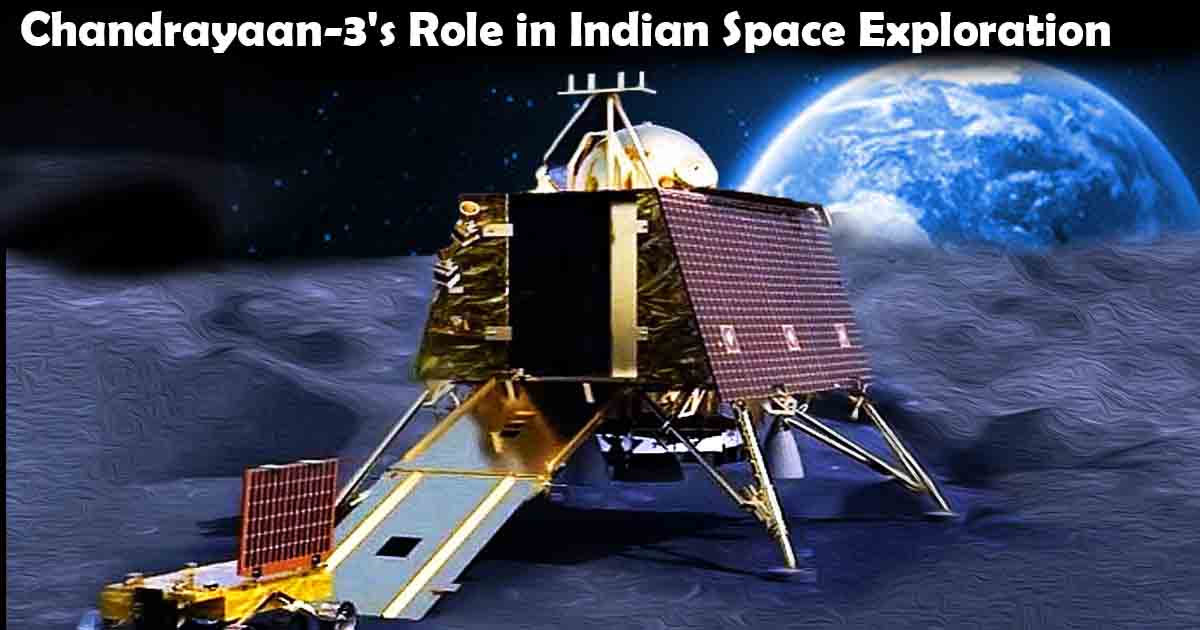
India’s Chandrayaan-3 mission marks a new chapter in space exploration. The successful soft landing near the Moon’s south pole establishes India as the first country to achieve this feat in such a challenging lunar location. This accomplishment opens new opportunities for India to become a leader in space exploration and influence humanity’s engagement with outer space.
What is the Chandrayaan-3 Programme?
Overview: Chandrayaan-3 is India’s third mission to the Moon and the second attempt at a soft landing. Launched from the Satish Dhawan Space Centre on July 14, 2023, it entered lunar orbit on August 5, 2023. On August 23, 2023, its lander successfully touched down near the lunar south pole.
Mission Objectives:
- To achieve a safe and soft landing on the Moon.
- To operate a rover on the lunar surface.
- To conduct in-situ scientific experiments.
Components:
- Propulsion Module: Transports the lander and rover to a 100 km lunar orbit. It carries the SHAPE payload to study the Earth’s spectral and polarimetric properties from lunar orbit.
- Lander Module (Vikram): Includes instruments like the ChaSTE for thermal measurements, the Instrument for Lunar Seismic Activity (ILSA) for seismic studies, and the Langmuir Probe (LP) for plasma density estimation. It also carries a Laser Retroreflector Array from NASA for lunar laser ranging.
- Rover Module (Pragyan): Equipped with an Alpha Particle X-ray Spectrometer (APXS) and Laser-Induced Breakdown Spectroscopy (LIBS) to analyze the elemental composition around the landing site.
Major Findings:
- Lunar Surface Temperature: The ChaSTE found temperatures reaching 70°C, higher than expected.
- Lunar Surface Elements: The LIBS on the Pragyan rover confirmed the presence of sulfur and other elements like aluminum, calcium, iron, chromium, titanium, manganese, silicon, and oxygen near the south pole.
Why is Chandrayaan-3 Important for India’s Space Programme?
Leadership in Space Technology:
- India joins an elite group of nations (Russia, the US, and China) with proven soft landing capabilities on the Moon.
- The mission demonstrates India’s advancements in cryogenic engines and orbital management, positioning it as a leader in space technology.
Strategic Significance:
- The soft landing capabilities have broader applications, such as enabling refueling and docking technologies and advancing robotic space missions.
- The mission contributes to defense and aerospace technologies, providing insights into missile defense systems and reusable launch vehicles.
Scientific Exploration:
- Chandrayaan-3’s payloads study the lunar atmosphere, surface, and subsurface, contributing to a deeper understanding of the Moon’s properties, including confirming water ice presence.
Economic and Strategic Tools:
- Technologies developed for Chandrayaan-3 have commercial applications, such as in disaster management and infrastructure monitoring.
- The mission’s success encourages space tourism and economic activities, fostering a growing space-tech ecosystem in India.
Future ISRO Space Missions
- Chandrayaan-4: Aims to be a sample return mission, building on Chandrayaan-3’s success and advancing lunar exploration.
- LUPEX: A joint mission with Japan’s JAXA to explore the Moon’s polar regions, particularly the permanently shadowed areas for potential water ice.
- XPoSat: India’s first dedicated polarimetry mission to study X-ray sources in extreme cosmic conditions.
- NISAR: A collaborative mission with NASA to provide consistent data on Earth’s changes, including ecosystems, ice masses, and natural hazards.
- Gaganyaan: A manned mission that plans to send Indian astronauts to space for up to seven days.
- Shukrayaan 1: An upcoming mission to Venus to study its geological and atmospheric characteristics.
- SPADEX: An experiment to mature technologies for docking, orbital rendezvous, and in-space satellite servicing.
Challenges in India’s Space Programme
Budget Constraints:
- India’s space program operates on a modest budget compared to other nations, with only 0.05% of its GDP allocated to space activities, unlike the US’s 0.25%.
Technological and Commercial Challenges:
- India ranks seventh globally in satellite operations and relies on foreign components for critical technologies.
- Challenges in the human spaceflight program include astronaut training and ensuring safety.
Policy and Market Development:
- India’s share in the global space economy is limited, and there is a need for policies that support space startups and private sector participation.
- Delays in space policy development could hinder progress in this sector.
Space Debris and Geopolitical Factors:
- Managing space debris and navigating geopolitical tensions, such as participating in the Artemis Accords, are crucial for India’s space strategy.
Path Forward for India’s Space Aspirations
To maximize its space potential, India must:
- Increase investments in space missions and technology development.
- Enhance expertise in human spaceflight and related infrastructure.
- Encourage private sector participation and align space policy with global trends.
- Address legal frameworks for space activities to ensure comprehensive governance.
- Promote international collaboration and public awareness to foster support for space initiatives.




